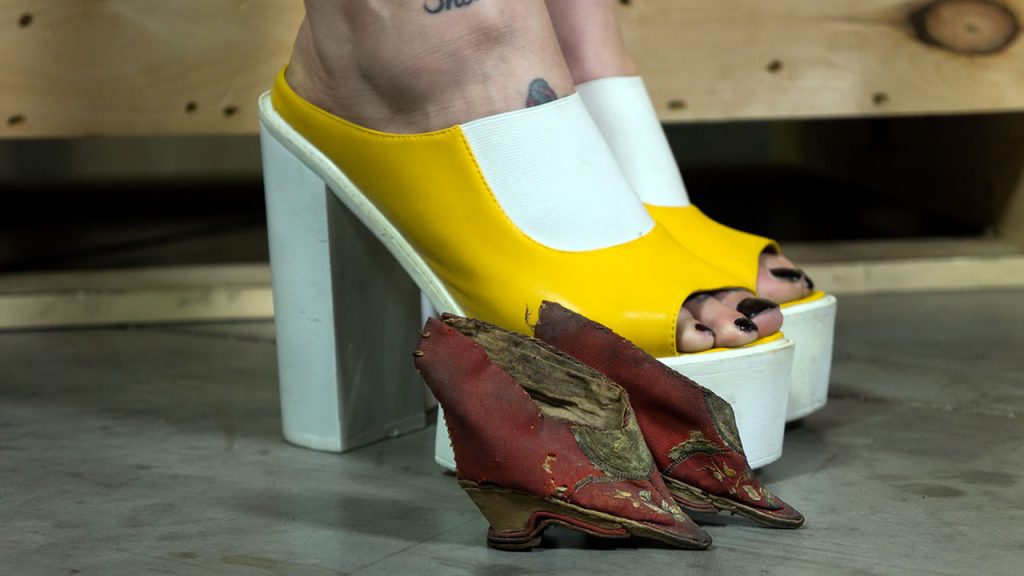Winner of the Fall 2016 StMU History Media Award for
Best Use of Scholarship
Best Article in the Category of “World History”
Best Use of Primary Sources
When I knew I couldn’t suffer another moment of pain and tears fell on my bloody bindings, my mother spoke softly into my ear, encouraging me to go one more hour, one more day, one more week, reminding me of the rewards I would have if I carried on a little longer. In this way, she taught me how to endure—not just the physical trials of footbinding or childbearing, but the more torturous pain of the heart, mind, and soul.1
More often than necessary, women are consumed with the idea of infatuation. Every culture has its own form of standards that pertain to women and what constitutes beauty. Although the world is slightly more accepting now, women used to go to extreme lengths to achieve an image that would be deemed attractive. In the Chinese culture, foot binding was that well-known beauty expectation for centuries. What started off as a celebrity fad, turned into a way of determining social status and eventually an all-around beauty expectation. 2 The objective of foot binding was for women to have the smallest foot possible, starting at very young ages. Not only was this a painful process for girls as young as five years, but it also promoted the idea that women must mutilate their bodies to become appealing to men. At some point in time, women began to just accept that this was something that was supposed to be done in order to be attractive. Often referred to as “lotus boats” or “golden lotuses,” bound feet started as a fad for the famous, and slowly made its way to becoming the social norm.3

This practice began around the tenth century with women in the entertainment business. These women were adored for their tiny arched feet and were seen by men to be much more attractive than middle class women with average feet. As these dancers were gaining an audience, the idea of “lotus feet” was becoming familiar. Not long after these performers expressed their “beauty,” foot binding became a norm for women who wanted to fit in and even for those who had a desire to find a husband.4 This painful process consisted of the breaking of young girl’s toes to form the desired triangular shape. Then the arch of the foot would be bent horizontally from the toes all the way to the heel. As if this was not painful enough, the girls were forced to walk on their feet to intensify the arch, breaking the foot even more. After all of this, the foot would be wrapped to maintain the shape of it as well as prevent any sort of deviation.5

Although this practice was around for centuries, it was only a matter of time before someone realized how inhumane and cruel it really was. Thankfully, many people began to protest against foot binding, forming “anti-foot binding organizations” to raise awareness on the inhumanity of binding women’s feet. By the 1950’s, laws were passed, allowing women to unbind their feet. Although hesitant at first, the trend slowly declined. Many women protested to unbinding their feet, due to the fact that it had been a social norm a thousand years. However, the movement against foot binding continued and eventually the last of the factories that make the tiny shoes were shut down, disabling the women from continuing the custom. Today, foot binding is no longer practiced and the only women who continue to maintain the tiny feet are those elder women who refuse to let go of the past.6
- Lisa See, Snow Flower and the Secret Fan (New York: Random House Publishers, 2005), 3-4. ↵
- Yaodong Gu et al., “Foot Loading Characteristics of Chinese Bound Feet Women: A Comparative Analysis,” PLoS ONE 10, no. 4 (April 2015): 1–9, doi:10.1371/journal.pone.0121695. ↵
- Yu-ning Li, Chinese Women Through Chinese Eyes (New York: Routledge, 2015), 125-127. ↵
- Women in the Middle Ages: An Encyclopedia, 2004, s.v. “Footbinding (Late 10th Century-early 20th Century),” by Patricia Buckley Ebrey. ↵
- Amanda Foreman, “Why Footbinding Persisted in China for a Millennium,” Smithsonian, accessed November 8, 2016, http://www.smithsonianmag.com/history/why-footbinding-persisted-china-millennium-180953971/. ↵
- “Women with Bound Feet in China,” Reshaping the Body: Clothing & Cultural Practice, accessed November 8, 2016, http://exhibits.hsl.virginia.edu/clothes/lady_bound/. ↵



189 comments
Eric Ortega Rodriguez
I remember hearing about foot binding in history class and it seemed so unbelievable that this was an actual beauty standard for a time. The images used in this article are very effective because it allows comparison between the different shoe sizes from back then to now. It is hard to believe that this stopped being a beauty standard until the 1950s when the laws were passed, which is not that long ago. Overall, excellent topic selection. Good work.
Maya Mani
It’s such a relief that this trend is gone. Beauty norms have evolved so much, and while many women feel pressured to look a certain way, at least there is not another trend that would go to such extremes. This was a very descriptive article, especially when describing the processes of foot binding. It sounds so painful, and the images make it even more horrifying.
Nadia Carrasco
To me this article was a very interesting read. It is so crazy to think that this foot binding was thought of as beautiful for such a long a time. What started from the entertainment business became a tradition in a culture. This goes to show how powerful the things we watch can get to people. It also shows all the different takes on what beauty is all around the world, and that to me is the main take out of this article.
Indhira Mata
I could only imagine how painful this practice could have been. I have heard that in china women had on average smaller feet compared to us. In high school we learned about feet binding and how as of little girls they would have to start this painful process. The pictures was able to provide to see how the feet binding would make it look and it does not look pretty at all. The article shows how in all places every woman wanted to be the prettiest.
Lamont Traylor
This article honestly made me laugh because it made me realize how insane people are. Why would foot binding every be something that is a social norm? They say in the article that women did it to be more attractive but the pain and consequences of it should be enough for people to have known that it was wrong or at least not pleasing to anyone.
Maisie Favila
Foot binding has always been so interesting to learn about so reading this article gave me a better insight on the process. I think it’s so cool to learn about this even if it’s very odd. These women would go through with this just to be seen as attractive to the community. I liked seeing the photos too because its always good to have an image put with words. Overall, this article was very well written and intriguing.
Alejandra Chavez
Really great article! I have heard about this and never thought much to it but vanity and it was interesting to hear about it all. The photos made the article even better because I was better able to see how this came out to be. It would be interesting to see how someone with a size 10 shoe made their size smaller and how it looked like in the end. I think it really crazy how this was seen as beautiful and am happy it is no longer a norm that women have to suffer.
Ariana Melendez
This article is hard to read because of the painful history of foot binding. Nonetheless it is full of description, including the complicated process of foot binding itself. It is hard to believe that this became a norm in China. I liked that this article was straight and to the point yet very informative of this cruel beauty standard.
Raymond Munoz
I remember in my sophomore year of high school when I had world history and we learned about how Chinese woman would practice foot binding. I hated learning about because the pictures also made me sick. This article also has some pictures that made me a little, but that’s not a bad thing, that just proves the accuracy of the article and how great it is.
Karina Cardona Ruiz
I think the way you started off your article with a quote from someone who had her feet bound was smart because it caught my attention as well as the attention of other readers I’m assuming. It’s sad to think that this painful mutilation was forced onto young girls who had to then carry on doing so. It’s shocking to me that this look was so adored and popularized. Even just looking at the photos of the bound feet made my own feet clench. I can’t believe it took so long to pass laws for unbinding and restrictions on binding but at least it will hopefully result in the trend dying out.